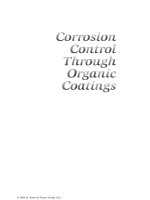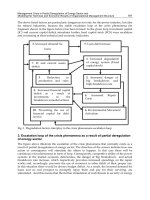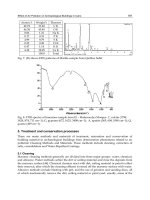Corrosion Control Through Organic Coatings Part 11 potx
Bạn đang xem bản rút gọn của tài liệu. Xem và tải ngay bản đầy đủ của tài liệu tại đây (231.65 KB, 7 trang )
7278_C008.fm Page 148 Saturday, February 4, 2006 12:47 PM
148
Corrosion Control Through Organic Coatings
— the variation in the corrosion rates for different coatings or different substrates
increases. Three samples sitting side by side in an accelerated test, for example, may
have a 3X, a 2X, and an 8X acceleration rates due to different vulnerabilities in different
coatings. The problem is that the person performing the test, of course, does not know
the acceleration rate for each sample. This can lead to incorrect ranking of coatings
or substrates when the accelerated test is completed.
The problem for any acceleration method, therefore, is to balance the amount
of acceleration obtained, with the variation (among different coatings or substrates).
The variation should be minimal and the acceleration should be maximal; this is not
trivial to evaluate because, in general, a higher acceleration can be expected to
produce more variation in acceleration rate for the group of samples.
8.3.1 ACCELERATION RATES
The amount of acceleration provided by a laboratory test could be considered as
quite simply the ratio of the amount of corrosion seen in the laboratory test to the
amount seen in field exposure (also known as “reference”) over a comparable time
span. It is usually reported as 2X, 10X, and so on, where 2X would be corrosion in
the lab occurring twice as quickly as in the field, as shown here:
A=
X accel t field
⋅
X field taccel
Where:
A is the rate of acceleration
Xaccel is the response (creep from scribe) from the accelerated test
Xfield is the response from field exposure
taccel is the duration of the acceleration test
tfield is the duration of the field exposure
For example, after running test XYZ in the lab for 5 weeks, 4 mm creep from
scribe was seen on a certain sample. After 2 years’ outdoor exposure, an identical
sample showed 15 mm creep from scribe. The rate of acceleration, A, could be
calculated as:
A=
(4 mm /5 weeks)
= 5.5
(15 mm/104 weeks)
8.3.2 CORRELATION COEFFICIENTS
OR
LINEAR REGRESSIONS
Correlation coefficients can be considered indicators of the uniformity of acceleration within a group of samples. Correlations by linear least square regression are
calculated for data from samples run in an accelerated test versus the response of
identical samples in a field exposure. A high correlation coefficient is taken as an
indication that the test accelerates corrosion more or less to the same degree for all
samples in the group. One drawback of correlation analyses that use least square
regression is that they are sensitive to the distribution of data [37].
© 2006 by Taylor & Francis Group, LLC
7278_C008.fm Page 149 Friday, February 3, 2006 3:01 PM
Corrosion Testing — Practice
149
8.3.3 MEAN ACCELERATION RATIOS
OF VARIATION
AND
COEFFICIENT
Another interesting approach to evaluating field data versus accelerated data is the
mean acceleration ratio and coefficient of variation [37].
To compare data from a field exposure to data from an accelerated test for a set
of panels, the acceleration ratio for each type of material (i.e., coating and substrate)
is calculated by dividing the average result from the accelerated test by the corresponding reference value, usually from field exposure. These results are then
summed up for all the panels in the set and divided by the number of panels in the
set to give the mean acceleration ratio. That is,
∑
MVQ =
n
X i ,accel
i =1 X i , field
n
+ / − σ n−1
Where:
MVQ is the mean value of quotients
Xi,accel is the response (creep from scribe) from the accelerated test for each sample i
Xi,field is the response from field exposure for each sample i
n is the number of samples in the set [37, 38]
This is used to normalize the standard deviation by dividing it by the mean value
(MVQ):
Coefficent of variation =
Test accel. =
MVQ ⋅
σ n−1
MVQ
t field
taccel
The coefficient of variation combines the amount of acceleration provided by
the test with how uniformly the corrosion is accelerated for a set of samples. It is
desirable, of course, for an acceleration test to accelerate the corrosion rate more or
less uniformly for all the samples; that is, the standard deviation should be as low
as possible. It follows naturally that the ratio of deviation to mean acceleration should
be as close to 0 as possible. A high coefficient of variation means that, for each set
of data, there is more spread in the amount of acceleration than there is actual
acceleration.
8.4 SALT SPRAY TEST
The salt spray (fog) test ASTM B117 (‘‘Standard Practice for Operating Salt Spray
(Fog) Testing Apparatus”) is one of the oldest corrosion tests still in use. Despite a
widespread belief among experts that the salt spray test is of no value in predicting
© 2006 by Taylor & Francis Group, LLC
7278_C008.fm Page 150 Friday, February 3, 2006 3:01 PM
150
Corrosion Control Through Organic Coatings
performance, or even relative ranking, of coatings in most applications, it is the most
frequently specified test for evaluating paints and substrates.
8.4.1 THE REPUTATION
OF THE
SALT SPRAY TEST
The salt spray test has such a poor reputation among workers in the field that the
word ‘‘infamous” is sometimes used as a prefix to the test number. In fact, nearly
every peer-reviewed paper published these days on the subject of accelerated testing
starts with a condemnation of the salt spray test [39-44]. For example:
•
•
•
‘‘In fact, it has been recognized for many years that when ranking the
performance levels of organic coating systems, there is little if any correlation between results from standard salt spray tests and practical experience.” [3]
‘‘The well-known ASTM B117 salt spray test provides a comparison of
cold-rolled and electrogalvanized steel within several hundred hours.
Unfortunately, the salt spray test is unable to predict the well-known
superior corrosion resistance of galvanized relative to uncoated cold rolled
steel sheet.” [45]
‘‘Salt spray provides rapid degradation but has shown poor correlation
with outdoor exposures; it often produces degradation by mechanisms
different from those seen outdoors and has relatively poor precision.” [46]
Many studies comparing salt spray results and actual field exposure have been
performed. Coating types, substrates, locations, and length of time have been varied.
No correlations have been found to exist between the salt spray and the following
service environments:
•
•
•
•
•
Galveston Island, Texas (16 months), 800 meters from the sea [47]
Sea Isle City, New Jersey (28 months), a marine exposure site [48]
Daytona Beach, Florida (3 years) [49]
Pulp mills at Lessebo and Skutskar, Sweden, painted hot-rolled steel
substrates (4 years) [50] and painted aluminium, galvanized steel and
carbon steel substrates (5 years) [51]
Kure Beach, North Carolina, a marine exposure site [52-54]
8.4.2 SPECIFIC PROBLEMS
WITH THE
SALT SPRAY TEST
Appleman and Campbell [55] have examined each of the accelerating stresses in
the salt spray test and its effect on the corrosion mechanism compared to outdoor
or ‘‘real-life’’ exposure. They found the following flaws in the salt spray test:
a. Constant humid surface
• Neither the paint nor the substrate experience wet /dry cycles. Corrosion mechanisms may not match those seen in the field; for example,
in zinc-rich coatings or galvanized substrates, the zinc is not likely to
form a passive film as it does in the field.
© 2006 by Taylor & Francis Group, LLC
7278_C008.fm Page 151 Friday, February 3, 2006 3:01 PM
Corrosion Testing — Practice
151
• Water uptake and hydrolysis are greater than in the field.
• A constant water film with high conductivity is present, which does
not happen in the field.
b. Elevated temperature
• Water, oxygen, and ion transport are greater than in the field.
• For some paints, the elevated temperature of the test comes close to
the glass transition temperature of the binder.
c. High chloride concentration (effect on corrosion depends on the type
of protection the coating offers)
• For sacrificial coatings, such as zinc-rich primers, the high chloride
content together with the constant high humidity means that the zinc
is not likely to form a passive film as it does in the field.
• For inhibitive coatings, chlorides adsorb on the metal surface, where
they prevent passivation.
• For barrier coatings, the osmotic forces are much less than in the field;
in fact, they may be reversed completely from that which is seen in
reality. In the salt spray test, corrosion at a scribe or defect is exaggeratedly aggressive compared with a scribe under intact paint.
Lyon, Thompson, and Johnson [56] point out that the high sodium chloride content
of the salt spray test can result in corrosion morphologies and behaviors that are not
representative of natural conditions. Harrison has pointed out that the test is inappropriate for use on zinc — galvanized substrates or primers with zinc phosphate pigments,
for example — because, in the constant wetness of the salt spray test, zinc undergoes
a corrosion mechanism that it would not undergo in real service [57]. This is a wellknown and well-documented phenomenon and is discussed in depth in chapter 7.
8.4.3 IMPORTANCE
OF
WET/DRY CYCLING
Skerry, Alavi, and Lindgren have identified three factors of importance in the degradation and corrosion of painted steel that are not modeled by the salt spray test:
wet/dry cycling, a suitable choice of electrolyte, and the effects of UV radiation
(critical because of the breakdown of polymer bonds in the paint) [3].
Lyon, Thompson, and Johnson explain why wet/dry cycles are an important
factor in an accelerated test method [56]:
Many studies have shown the specific importance of wetting and drying on atmospheric
corrosion... On a dry metal surface, as the relative humidity (RH) is increased, the
corrosion rate initially rises, then decreases to a relatively constant value which becomes
greater as the RH is increased. A similar effect is observed during physical wetting
and drying of a surface. Thus, on initial wetting, the corrosion rate rises rapidly as
accumulated surface salts first dissolve. The rate then decreases as the surface electrolyte dilutes with continued wetting. The corrosion rate also rises significantly during
drying because of both the increasing ionic activity as the surface electrolyte concentrates
© 2006 by Taylor & Francis Group, LLC
7278_C008.fm Page 152 Friday, February 3, 2006 3:01 PM
152
Corrosion Control Through Organic Coatings
and the reduced diffusion layer thickness for oxygen as the condensed phase become
thinner. However, eventually, when the ionic strength of the electrolyte layer becomes
very high and salts begin to crystallize, the corrosion rate decreases.
Simpson, Ray, and Skerry agree that ‘‘cyclic wetting and drying of electrolyte layers
from the panel surface is thought to stress the coating in a more realistic manner
than, for example, a continuous ASTM B-117 salt spray test, where panels are placed
in a constant, high relative humidity (RH) environment” [58]. Several workers in
this field have reported that cyclic testing with a significant amount of drying time
yields more realistic results on zinc-coated substrates [59-61].
REFERENCES
1.
2.
3.
4.
5.
6.
7.
8.
9.
10.
11.
12.
13.
14.
15.
16.
17.
18.
19.
20.
21.
22.
23.
24.
25.
Goldie, B., Prot. Coat. Eur., 1, 23, 1996.
Appelman, B., J. Coat. Technol., 62, 57, 1990.
Skerry, B.S., Alavi, A., and Lindgren, K.I. J. Coat. Technol., 60, 97, 1988.
Townsend, H., Development of an improved laboratory corrosion test by the automotive and steel industries, in Proc. 4th Annual ESD Advanced Coatings Conference,
Dearborn, MI, 8-10 November 1994. Engineering Society of Detroit (ESD), 1994.
Prfung des korrosionsschutzes von kraftfahrzeuglackierungen bei zyklisch wechselnder beanspruchung, Std. VDA 621-415, German Association of the Automotive
Industry, Frankfurt, Germany.
Accelerated corrosion test, Corporate Standard STD 423-0014, Issue 1, Volvo Group,
Gothenburg, 2003.
Ström, M., in Proc. Conf. Automotive Corrosion and Prevention. Dearborn, MI, Dec
4-6, 1989, Society of Automotive Engineers, Warrendale, PA, 1989.
Ström, M. and Ström, G., Proc. Skan Zink ’91, Helsingör (Sweden), Sept. 1991.
Pletcher, D., A First Course in Electrode Processes, The Electrochemical Consultancy
Ltd., Romsey, England, 1991, 229.
ISO 4628/3-1982-Designation of degree of rusting, International Organization for
Standardization, Geneva, 1982.
Paul, S., (Ed.), Surface Coatings: Science & Technology, 2nd ed., John Wiley & Sons,
Chichester, England. 1996.
Sacco, E.A. et al., Lat. Am. Appl. Res. 32, 4, 2002.
Walker, P., Paint Technol., 31, 22. 1967.
Özcan, M., Dehri, I. and Erbil, M., Prog. Org. Coat., 44, 279, 2002.
Lavaert, V. et al., Prog. Org. Coat., 38, 213, 2000.
Krolikowska, A., Prog. Org. Coat., 39, 37, 2000.
Sekine, I., Proc. 99th Symposium on Corrosion Protection, Tokyo, Japan, 1994, 51.
Sekine, I. and Yuasa, M., Proc. Annual Meeting of the Japan Society of Colour
Material, Tokyo, 1995, 70.
Sekine, I., Prog. Org. Coat., 31, 73, 1997.
Kendig, M. and Scully, J. Corrosion, 46, 22, 1990.
Walter, G.W., Corros. Sci., 32, 1041, 1991.
Walter, G.W., Corros. Sci.,32, 1059, 1991.
Walter, G.W., Corros. Sci.,32, 1085, 1991.
M. Stratmann et al., Corros. Sci.,6, 715, 1990.
Forsgren, A. and Thierry, D., Corrosion properties of coil-coated galvanized steel,
using field exposure and advanced electrochemical techniques, SCI Rapport 2001:4E.
Swedish Corrosion Institute (SCI), Stockholm, 2001.
© 2006 by Taylor & Francis Group, LLC
7278_C008.fm Page 153 Wednesday, March 1, 2006 12:43 PM
Corrosion Testing — Practice
153
26. Bard, A.J. and Faulkner, L.R., Electrochemical Methods, John Wiley & Sons, New
York, 1980, chap. 6.
27. Glicinski, A.G. and Hegedus, C.R., Prog. Org. Coat., 32, 81, 1997.
28. Joanicot, M., Granier, V. and Wong, K., Prog. Org. Coat., 32, 109, 1997.
29. Gerharz, B., et al., Prog. Org. Coat., 32, 75, 1997.
30. Tzitzinou, A. et al., Prog. Org. Coat., 35, 89, 1999.
31. Forsgren, A. and Persson, D., Changes in the Surface Energy of Steel Caused by
Acrylic Waterborne Paints Prior to Cure, SCI Rapport 2000:5E. Swedish Corrosion
Institute (SCI), Stockholm, 2000.
32. Almeida, E., Balmayore, M. and Santos, T., Prog. Org. Coat., 44, 233, 2002.
33. Shaw, D., Introduction to Colloid and Surface Chemistry, 4th ed., ButterworthHeinemann Ltd., 1991, chapters 3 and 5.
34. Kim, K.S, Winograd, N. and Davis, R.E., J. Amer. Chem. Soc., 93, 6296, 1971.
35. Skerry, B.S. and Eden, D.A., Prog. Org. Coat., 15, 269, 1987.
36. Chen, C.T. and Skerry, B.S., Corrosion, 47, 598, 1991.
37. Ström, M. and Ström. G., SAE Technical Paper Series, 932338. Society of Automotive
Engineers, Warrendale, PA, 1993.
38. Ström, M., Utviklingen av metallbelegg i bilindustrin: Status, trender og Volvos
erfaringer, in Proc Overflatedager ’92, Trondheim, 1992. (in Norwegian)
39. LaQue, F.L., Marine Corrosion, Wiley, New York, 1975.
40. Lambert, M.R., et al., Ind. Eng. Chem. Prod. Res. Dev., 24, 378, 1985.
41. Lyon, S.B. et al., Corrosion, 43, 12, 1987.
42. Timmins, F.D., J. Oil Color Chem. Assn., 62, 131, 1979.
43. Funke, W., J. Oil Color Chem. Assn., 62, 63, 1979.
44. Skerry, B.S. and Simpson, C.H., Corrosion, 49, 663, 1993.
45. Townsend, H.E., Development of an improved laboratory corrosion test by the
automotive and steel industries, in Proc. 4th Annual ESD Advanced Coating Conference, Dearborn, MI, 8-10 November 1994. Engineering Society of Detroit (ESD),
1994.
46. Appleman, B., J. Prot. Coat. Linings, 6, 71, 1989.
47. Struemph, D.J. and Hilko, J., IEEE Trans. on Power Delivery, PWRD-2, 823,
1987.
48. Chong, S.L., Comparison of laboratory testing method for bridge coatings, in Proc.
4th World Congress on Coating Systems for Bridge and Steel Structures Bridging the
Environment, St. Louis, MO, 1995.
49. Rommal, H.E.G. et al., Accelerated test development for coil-coated steel building
panels, in Proc. Corrosion ’98, San Diego, CA, National Association of Corrosion
Engineers (NACE), 1998, Paper 356.
50. Forsgren, A. and Palmgren, S., Salt spray test vs. field results for coated samples: part I,
SCI Rapport 1998:4E, Swedish Corrosion Institute (SCI), Stockholm, 1998.
51. Forsgren, A., Rendahl, B. and Appelgren, C., Salt spray test vs. field results for coated
samples: part II, SCI Rapport 1998:6E, Swedish Corrosion Institute (SCI), Stockholm,
1998.
52. Appleman, B.R., Bruno, J.A., and Weaver, R.E.F., Performance of Alternate Coatings
in the Environment (PACE) Volume I: Ten Year Field Data, FHWA-RD-89-127, U.S.
Federal Highway Administration, Washington D.C., 1989.
53. Appleman, B.R., Weaver, R.E.F. and Bruno, J.A., Performance of Alternate Coatings
in the Environment (PACE) Volume II: Five Year Field Data and Bridge Data of
Improved Formulations, FHWA-RD-89-235, U.S. Federal Highway Administration,
Washington D.C., 1989.
© 2006 by Taylor & Francis Group, LLC
7278_C008.fm Page 154 Wednesday, March 1, 2006 12:43 PM
154
Corrosion Control Through Organic Coatings
54. Appleman, B.R., Weaver, R.E.F. and Bruno, J.A., Performance of Alternate Coatings
in the Environment (PACE) Volume III: Executive Summary, FHWA-RD-89-236, U.S.
Federal Highway Administration, Washington D.C., 1989.
55. Appleman, B.R. and Campbell, P.G., J. Coat. Technol., 54, 17, 1982.
56. Lyon, S.B., Thompson, G.E. and Johnson, J.B., Materials evaluation using wet-dry
mixed salt spray tests, in New Methods for Corrosion Testing of Aluminum Alloys,
ASTM STP 1134, V.S. Agarwala and G.M. Ugiansky, Eds., American Society for
Testing and Materials, Philadelphia, PA, 1992, 20.
57. Harrison, J.B. and Tickle, T.C., J. Oil Color Chem. Assn., 45, 571, 1962.
58. Simpson, C.H, Ray, C.J. and Skerry, B.S., J. Prot. Coat. Linings, 8, 28, 1991.
59. Smith, D.M. and Whelan, G.W., SAE Technical Paper Series, 870646, Society of
Automotive Engineers, Warrendale, PA, 1987.
60. Nowak, E.T., Franks, L.L. and Froman, G.W., SAE Technical Paper Series, 820427,
Society of Automotive Engineers, Warrendale, PA, 1982.
61. Standish, J.V., Whelan, G.W. and Roberts, T.R., SAE Technical Paper Series, 831810.
Society of Automotive Engineers, Warrendale, PA, 1983.
© 2006 by Taylor & Francis Group, LLC









